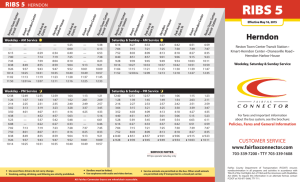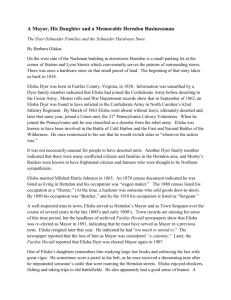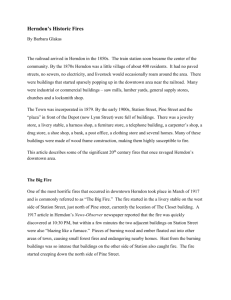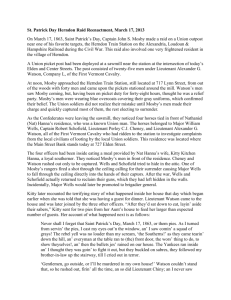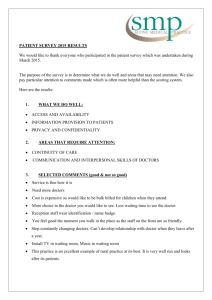Click here for the entire article
advertisement
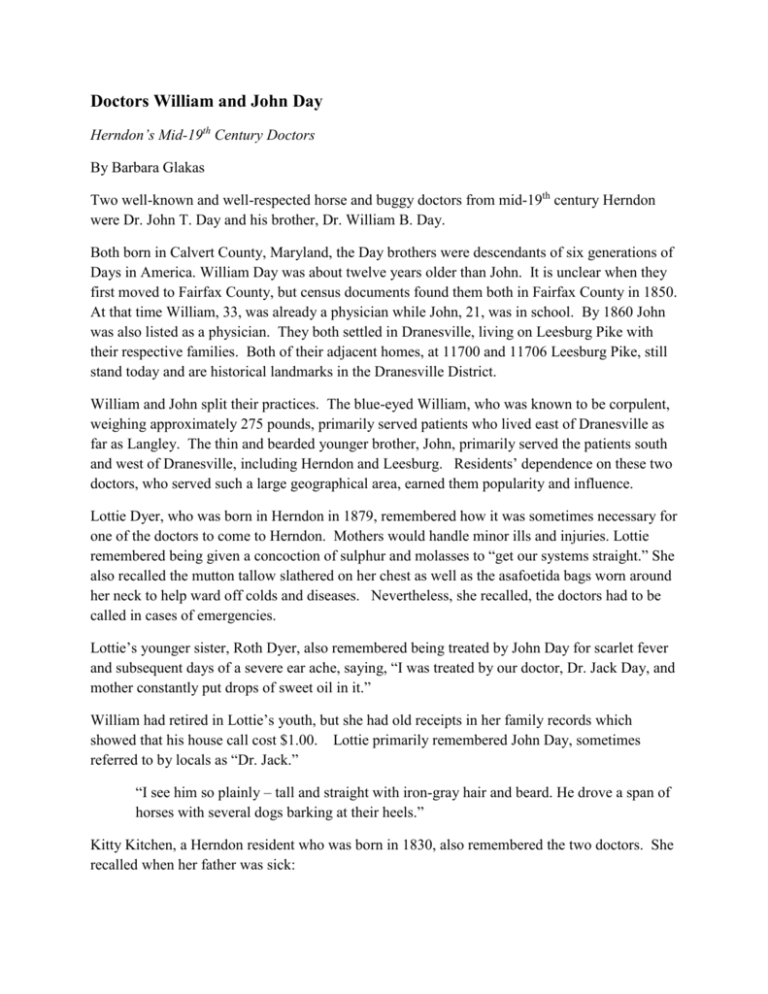
Doctors William and John Day Herndon’s Mid-19th Century Doctors By Barbara Glakas Two well-known and well-respected horse and buggy doctors from mid-19th century Herndon were Dr. John T. Day and his brother, Dr. William B. Day. Both born in Calvert County, Maryland, the Day brothers were descendants of six generations of Days in America. William Day was about twelve years older than John. It is unclear when they first moved to Fairfax County, but census documents found them both in Fairfax County in 1850. At that time William, 33, was already a physician while John, 21, was in school. By 1860 John was also listed as a physician. They both settled in Dranesville, living on Leesburg Pike with their respective families. Both of their adjacent homes, at 11700 and 11706 Leesburg Pike, still stand today and are historical landmarks in the Dranesville District. William and John split their practices. The blue-eyed William, who was known to be corpulent, weighing approximately 275 pounds, primarily served patients who lived east of Dranesville as far as Langley. The thin and bearded younger brother, John, primarily served the patients south and west of Dranesville, including Herndon and Leesburg. Residents’ dependence on these two doctors, who served such a large geographical area, earned them popularity and influence. Lottie Dyer, who was born in Herndon in 1879, remembered how it was sometimes necessary for one of the doctors to come to Herndon. Mothers would handle minor ills and injuries. Lottie remembered being given a concoction of sulphur and molasses to “get our systems straight.” She also recalled the mutton tallow slathered on her chest as well as the asafoetida bags worn around her neck to help ward off colds and diseases. Nevertheless, she recalled, the doctors had to be called in cases of emergencies. Lottie’s younger sister, Roth Dyer, also remembered being treated by John Day for scarlet fever and subsequent days of a severe ear ache, saying, “I was treated by our doctor, Dr. Jack Day, and mother constantly put drops of sweet oil in it.” William had retired in Lottie’s youth, but she had old receipts in her family records which showed that his house call cost $1.00. Lottie primarily remembered John Day, sometimes referred to by locals as “Dr. Jack.” “I see him so plainly – tall and straight with iron-gray hair and beard. He drove a span of horses with several dogs barking at their heels.” Kitty Kitchen, a Herndon resident who was born in 1830, also remembered the two doctors. She recalled when her father was sick: “When he was took with consumption, which went hard with him, Dr. Bill Day – the ‘old doctor’ they called him after Doc Coleman was gone – tended him faithful; an’ his brother, Doctor Jack, who was the ‘young doctor’ then, he used to come sometimes too, an’ sometimes they’d stay to dinner.” Kitty also recalled a skirmish during the Civil War when one of John Mosby’s Confederate soldiers, French Dulaney, was shot and wounded in the area: “They sent for Doctor Jack, who came at onct; an’ the doctor sent to me for some brandy, knowing I had little on hand. I gave all I had, but poor French died.” John Day was known to sometimes allow patients to pay bills in installments or through bartering. In December of 1867 John Day treated Herndon resident William Robey for two days in a row. The total bill, including the visit, treatment and medicine, was $4.75. Dr. Day’s records showed that he received $2.00 in 1869 and $1.00 in 1871. The bill was finally settled in 1875 when Dr. Day obtained two slop jars from Mr. Robey’s general store in Herndon. Despite these appreciative memories of the two doctors, many of their local activities during the war were sometimes controversial, depending on one’s perspective about “Yankees” and “Rebels.” William Day, a slave holder himself, was described as being a conservative man of great wealth and influence who hated the idea of the abolition of slavery and wanted to conserve the south. One informant reported that William Day had once said that “he would do all that lay in his power against Lincoln,” and would try to persuade others to join the rebel army. One of his most famous affairs was when he and several other Dranesville residents, including John Day, were accused of seeking out and attacking four Union pickets in the vicinity of Lowes Island, about six miles north of Herndon. Two of the Union pickets ended up being killed. Recounted from statements on the General Records of the Department of State, one woman reported that William Day had stripped the clothes off of the dead bodies, boasted about the having taken them from the “damn Yankees” and gave the clothes to his own slaves. John Day was reported to have sent a man named Jimmy back to bury the two stripped dead men; Jimmy later reported that he buried one man but the other had already been “eaten up” by hogs. Yet another man stated that William Day was “the most bitter secessionist in the neighborhood, that he has been particularly active and influential in the persecution of Union men.” Another resident said William Day attempted to gather men to form a company to go to Bull Run. When one man expressed reluctance about going, Dr. Day responded that if he did not go “that he would have me, dead or alive.” Still another resident reported that Dr. William Day had used his influence in favor of the rebellion and said, “In my opinion, Wm. B. Day had done more against the Union than any other man in town.” At one point a notice was placed on the Herndon Station calling up all citizens to come forth a take an oath of allegiance to support the Confederate States government or leave the country. William Day also tried to pressure residents to vote for secessionist candidates, threatening them with being “marked” if they did not do so. Needless to say, William was well-known to be a rabid secessionist. In 1862 William was appointed as assistant surgeon at Winchester Hospital as well as other Confederate hospitals, serving as a contract surgeon for the Confederacy. He was also known to have enlisted in Cobb’s Georgia Legion as a physician. John was not known to have ever enlisted in the military but worked in support of the Confederacy. Both doctors ended up in the Union’s Capitol Prison in Washington, D.C. in 1861. Col. George D. Bayard, who commanded the 1st Pennsylvania Cavalry, reported that he “arrested six of the citizens of Dranesville who are known to be secessionists of the bitterest stamp.” Those six citizens included both William and John Day. They were charged with murdering and robbing the Federal soldiers at Lowes Island. William Day later said that while in prison they could hear carpenters hammering and they feared a gallows was being constructed to hang them. He said his brother, John, prayed on his knees, loud an often, to be spared from the gallows. Kitty Kitchen recalled: “[Dr. Jack] an’ his brother, Doctor Bill, was put in old Capitol Prison… The folks got up a petition an’ everybody signed it, to get’ em out, for they was good an’ useful men, an’ badly needed in our country. It was summer time when they got out’n prison. Doctor Bill went to Richmond for a time, but Doctor Jack stayed at his house in Dranesville as long as he could, tho’ at las’ he too went to Richmond, bein’ a hot Secessioner.” John Day was released conditionally upon taking an oath of allegiance to the United States. William’s murder charges were never indisputably proved and he was released in 1862 as a result of a prisoner exchange. Both doctors were listed as still living in Dranesville in the 1870 and 1880 census documents. John continued to practice as a local physician after William retired. John also became a devoted Episcopalian. He was one of the earliest members of St. Timothy’s Episcopal Church formerly located at Elden and Center Streets. His name appeared as Trustee on the deed in 1876 and on the church mission records in 1877 when he was elected to the Vestry and agreed to be the Treasurer. He was a Senior Warden for 15 years. The Herndon Masonic Lodge occupies the old church building today at 820 Elden Street. Kitty again recalled: “Doctor Jack was the mos’ enthusiastic of all, ‘cause Mis’ Jack, she’d won him over to be ‘Piscopal, an’ he never done things by half; so in all sorts of weather he’d drive miles to church, given’ so many of his hard earned dollar to support The Mission, he died poor, they say…. I know he had treasures laid up, as you say, an’ the picture on his memorial window is topped by crown above the cross. … Anyhow, we love to think of Doctor Jack, so tall an’ redfaced, with long gray beard ad flowin’ locks, drivin’ so fas ‘round the county, in a two horse buggy, his dogs followin’ him a-barkin’ an’ racin’.” Dr. William Day died in 1886 and is buried in the Day Family cemetery off of Brown’s Mill Road in Vienna, Virginia. Dr. John Day died in 1893 and is buried in Herndon’s Chestnut Grove Cemetery. John’s funeral consisted of both a Episcopalian service and a Masonic Ritual. A Fairfax Journal obituary said of the funeral, “there was the largest attendance…that was ever seen at this place.” In about 1900, devoted church members, friends and patients of John Day installed a memorial stained glass window in the old St. Timothy’s Church on Elden Street. The large window, approximately 14 feet high by 5 feet wide, eventually suffered from weather exposure. In the late 1980s the Masons moved the window from the outer wall, made necessary repairs, and placed it in a position inside the building, hanging behind the chair for the Mason’s Worshipful Master. The beautiful memorial stain glass window, dedicated to Dr. John T. Day, is still in Herndon’s Masonic Lodge today. About this column: “Remembering Herndon’s History” is a regular Herndon Patch feature offering stories and anecdotes about Herndon’s past. The articles are written by members of the Herndon Historical Society. Barbara Glakas is a member. A complete list of “Remembering Herndon’s History” columns is available on the Historical Society website at www.herndonhistoricalsociety.org. The Herndon Historical Society operates a small museum that focuses on local history. It is housed in the Herndon Depot in downtown Herndon on Lynn Street and is open every Sunday from noon until 3:00. Visit the Society’s website at www.herndonhistoricalsociety.org, and the Historical Society’s Facebook page at https://www.facebook.com/HerndonHistory for more information. Note: The Historical Society is seeking volunteers to help keep the museum open each Sunday. If you have an interest in local history and would like to help, contact HerndonHistoricalSociety@gmail.com.
